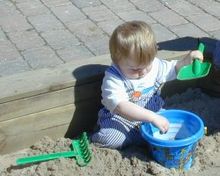Play sand
A special variant of a sand is referred to as play sand , which is particularly suitable or should appear suitable (as a sales item to the customer) in particular for filling sandboxes .
Play sand, like normal sand, has a grain size of 0.063–2 mm.
Play sand is usually offered in transportable bags in weights of 10 to 25 kg . A cleverly chosen sales strategy (for example, by selling sand declared as play sand in toy shops and in attractive packaging) usually achieves a higher sales price than would be possible with normal sand (e.g. in the construction industry for the production of cement ). Due to this fact, it is possible that sand declared as play sand can cover long distances from the producer to the customer.
properties
Due to its relatively small grain size of 0–2 mm, play sand has a relatively high adhesive force when wet , which makes it possible to create shapes. The negative property of the small grain size is expressed in the low fall absorption. Play sand, for example, is not suitable for being spread under swings in order to cushion a fall. In this respect, it differs from fall protection sand , which with a grain size of up to 8 mm has hardly any adhesive force, but offers increased fall absorption.
Legal regulations
In Germany it is not clearly regulated by law that sand that has been declared as play sand must be used to fill sandboxes. There are also no legally stipulated templates, for example a fixed exchange interval. However, the city of Hamburg, for example, recommends an exchange interval between 12 and 24 months. It is also recommended to keep the play sand free of dogs and cats (or their excrement) and to rake the sand regularly. Other federal states make similar recommendations.
Individual evidence
- ↑ GUV information: outdoor play areas and playground equipment. In: publications.dguv.de. Retrieved February 21, 2015 .
- ↑ Test reports play sand - ÖKO-TEST Online - www.oekotest.de. In: oekotest.de. Retrieved February 21, 2015 .
- ↑ Jörg Rampke: Playground maintenance means playground safety . Beuth Verlag , Berlin 2013, ISBN 978-3-410-23137-0 , pp. 23 .
- ↑ Fall protection. In: spielplatzpruefer.com. Retrieved February 22, 2015 .
- ↑ Recommendations for day care for health and hygiene. (PDF) ESF project: Child day care in association. In: hamburg.de. Free and Hanseatic City of Hamburg, accessed on February 22, 2015 .
